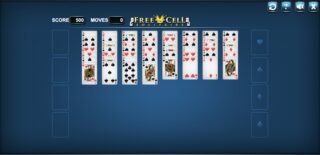- Wondering how to get Monopoly GO! free rolls? Well, you’ve come to the right place. In this guide, we provide you with a bunch of tips and tricks to get some free rolls for the hit new mobile game. We’ll …
Best Roblox Horror Games to Play Right Now – Updated Weekly
By Adele Wilson
Our Best Roblox Horror Games guide features the scariest and most creative experiences to play right now on the platform!The BEST Roblox Games of The Week – Games You Need To Play!
By Sho Roberts
Our feature shares our pick for the Best Roblox Games of the week! With our feature, we guarantee you'll find something new to play!All Grades in Type Soul – Each Race Explained
By Adele Wilson
Our All Grades in Type Soul guide lists every grade in the game for all races, including how to increase your grade quickly!
Gamezebo: Comparing Klondike Solitaire and FreeCell Solitaire – Similarities and Differences
Solitaire is a stone cold classic card game, but many don’t know it boasts many iterations – many quite different from each other.

Solitaire is a stone cold classic card game, but many don’t know it boasts many iterations – many quite different from each other.
So we thought we’d take the chance to explain five of the key differences between two of the most popular variants, Klondike and FreeCell.
Their set up: Both versions use a 52 card deck as you’d expect, as well as tableaus, foundation piles, and free cells in their set up. Klondike’s tableau has seven piles, leaving room for four foundation piles. You deal cards from left to right with an ascending number of cards for every stack. The first column has a single card, the second column two cards, and so on. All cards are dealt face down, although for each column you turn the uppermost card face up after completing the deal.
FreeCell however has eight foundation piles. The first four columns from your left has seven cards each, whereas the last four cards have six cards each. You then divide the remaining cards into the four free cells above the tableau positioned on the left side. On the right of the play area you set a space for the foundation piles, and then all cards are dealt out face-up.

Solvability: FreeCell is by far the most logical option if you’re looking for an easier version of Solitaire from the two. This is because in FreeCell all the cards in the eight columns are shown face up as mentioned above – whereas in Klondike only the top cards in the seven given columns are displayed. That can make a massive difference in terms of strategy and having a chance to complete the game.
Final objective: In Klondike the final aim is to move all your cards to their respective foundations piles. In Freecell you move the cards to their separate foundation piles.
Variations: In Klondike you have 2-Deck and Double variations, but Frecell can be expanded even further in 3-deck and 4-deck iterations.
History: Not significant in how they’re played, but it’s worth noting that Klondike was invented in the late nineteenth century – whereas Freecell is a baby in comparison, having been created in 1978 by Paul Alfille (a digital version was then made available in 1995.
If you want to play FreeCell Solitaire online this site is as good a place as any – and the same goes for if you want to play Klondike Solitaire online.
More articles...
Monopoly GO! Free Rolls – Links For Free Dice
By Glen Fox
Wondering how to get Monopoly GO! free rolls? Well, you’ve come to the right place. In this guide, we provide you with a bunch of tips and tricks to get some free rolls for the hit new mobile game. We’ll …Best Roblox Horror Games to Play Right Now – Updated Weekly
By Adele Wilson
Our Best Roblox Horror Games guide features the scariest and most creative experiences to play right now on the platform!The BEST Roblox Games of The Week – Games You Need To Play!
By Sho Roberts
Our feature shares our pick for the Best Roblox Games of the week! With our feature, we guarantee you'll find something new to play!All Grades in Type Soul – Each Race Explained
By Adele Wilson
Our All Grades in Type Soul guide lists every grade in the game for all races, including how to increase your grade quickly!







